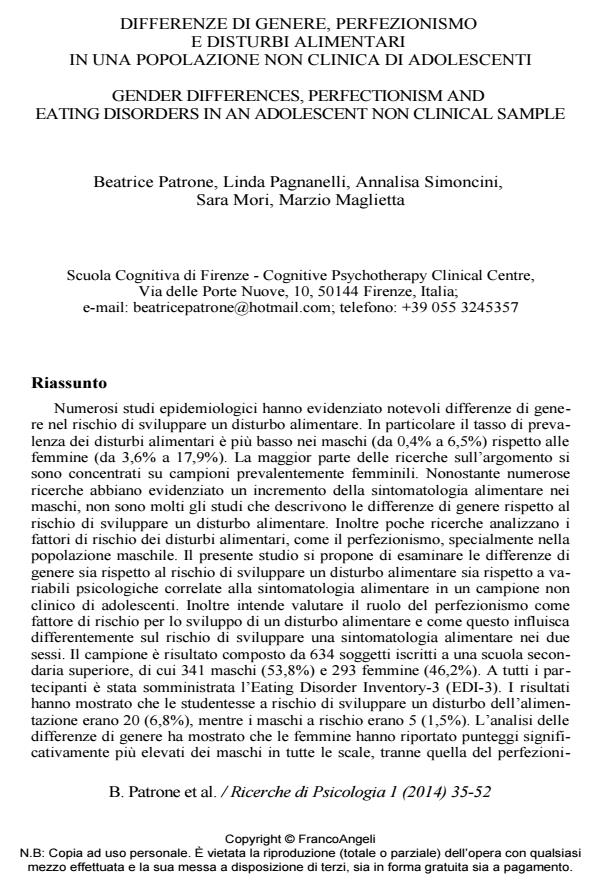Gender differences, perfectionism and eating disorders in an adolescent non clinical sample
Journal title RICERCHE DI PSICOLOGIA
Author/s Beatrice Patrone, Linda Pagnanelli, Annalisa Simoncini, Sara Mori, Marzio Maglietta
Publishing Year 2014 Issue 2014/1
Language Italian Pages 18 P. 35-52 File size 206 KB
DOI 10.3280/RIP2014-001002
DOI is like a bar code for intellectual property: to have more infomation
click here
Below, you can see the article first page
If you want to buy this article in PDF format, you can do it, following the instructions to buy download credits

FrancoAngeli is member of Publishers International Linking Association, Inc (PILA), a not-for-profit association which run the CrossRef service enabling links to and from online scholarly content.
Several epidemiological studies highlighted remarkable gender differences about the risk of the development of an Eating Disorder. Particularly, the prevalence rate of Eating Disorders is lower on males (0.4%-6.5%) than on females (3.6%-17.9%). The majority of the researches about this subject were focused on mainly feminine samples. Despite that many researches pointed out on the increasing of eating symptoms on males, there are not many studies describing gender differences about the risk of the development of an Eating Disorder. Moreover few studies examine the risk factors of Eating Disorders, such as the perfectionism, especially on male population. The present study is directed to examine gender differences both about the risk of the development of an Eating Disorder and about psychological variables connected to eating symptoms, on a non clinical population of adolescents. Furthermore this study is directed to evaluate the role of the perfectionism as a risk factor of Eating Disorder and to analyze how the perfectionism differently affects the risk of eating symptoms on the two genders. The sample was composed by 634 individuals attending a secondary school, 341 males (53.8%) and 293 females (46.2%). All the participants completed the Eating Disorder Inventory-3 (EDI-3). The results showed that female students at risk to develop an Eating Disorder were 20 (6.8%), whereas male students at risk were 5 (1.5%). The analysis of gender differences showed that females reported significantly higher scores compared to males on all the EDI-3 subscales, except for the perfectionism. In the whole sample, high perfectionist individuals resulted at a higher risk of Eating Disorder compared to not high perfectionist. The analysis of gender differences showed that, notwithstanding high perfectionist males were more numerous compared to high perfectionist females, these latest were at a higher risk of Eating Disorder. Considering the recent increasing of the prevalence of Eating Disorders on male adolescents, these results underline the need of further studies directed to analyze the peculiarity of the development of Eating Disorders on males.
Keywords: Eating disorder, perfectionism, gender differences, Eating Disorder Inventory EDI-3, adolescence, risk factors.
Beatrice Patrone, Linda Pagnanelli, Annalisa Simoncini, Sara Mori, Marzio Maglietta, Differenze di genere, perfezionismo e disturbi alimentari in una popolazione non clinica di adolescenti in "RICERCHE DI PSICOLOGIA " 1/2014, pp 35-52, DOI: 10.3280/RIP2014-001002